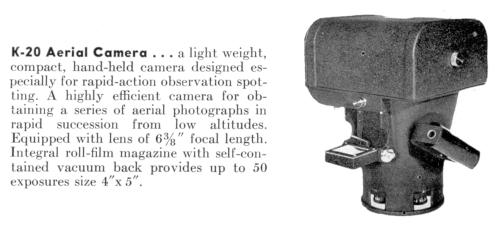A strange new camera
Guess what I found at the flea market today!
It’s heavy — 15 to 20 pounds. It’s clearly made entirely of cast steel or brass, painted with a pebbled black anti-reflection finish. It’s beat all to hell and has a military ID plate on it. It is a Fairchild K-20 Aerial Reconnaissance Camera. And it cost 30 dollars! Awesome.
(“Light weight”? You have GOT to be kidding. I guess compared to the behemoths that they mount in dedicated reconnaissance planes it’s lightweight, yeah, but this thing is three times of the weight of any other camera on my shelf.)
This is certainly one of the strangest cameras I own. It has a fixed focal length and only three shutter speeds, but a steplessly variable aperture. The shutter release is a pistol trigger on the right handgrip. The flip-up viewfinder is an enormous glass lens with a crosshair inscribed on it and bent wire with a ball on the end sticking out in front — you align the ball with the crosshair and you know you’re on-axis. Incidentally, this is exactly how aircraft gunsights worked before the reflector sight was invented.
From what I understand of the history, these cameras were most commonly used in B-17s and B-24s in the Second World War to assess bomb damage on the ground. Someone would basically just hang out the window (or look down through the bombardier’s pit) with the camera around their neck and snap photos of the destruction for later analysis. Given where I found it, it’s more likely that this was used in training, but It’s possible that someone could have taken it up in a CF-101 or similar.
The thing uses 5″ film. Not 4×5 sheets; a 5 inch, 200 foot roll that would I suppose hold around 450 exposures. These types of aerial cameras also usually have a vacuum system that holds the film flat against the plane while shooting; I don’t see a vacuum connector anywhere on this camera, so it likely has an internal vacuum pump (yep, really). I cracked the back open in the store and saw that, amazingly, this thing still has film in it. I quickly closed it back up — not likely to be good any more, but if there was anything on it hopefully I didn’t fog the internal shots too badly. I’ve avoided opening the back again until I can get it into a darkroom for developing. I wonder what’d be on it? There was a recon wing at CFB Trenton back in the 50s and 60s, which would have been about the right era for this camera to be in use…aerial photos of southern Ontario farms, then? Or will it turn out to be Soviet missile bases? Stay tuned…
